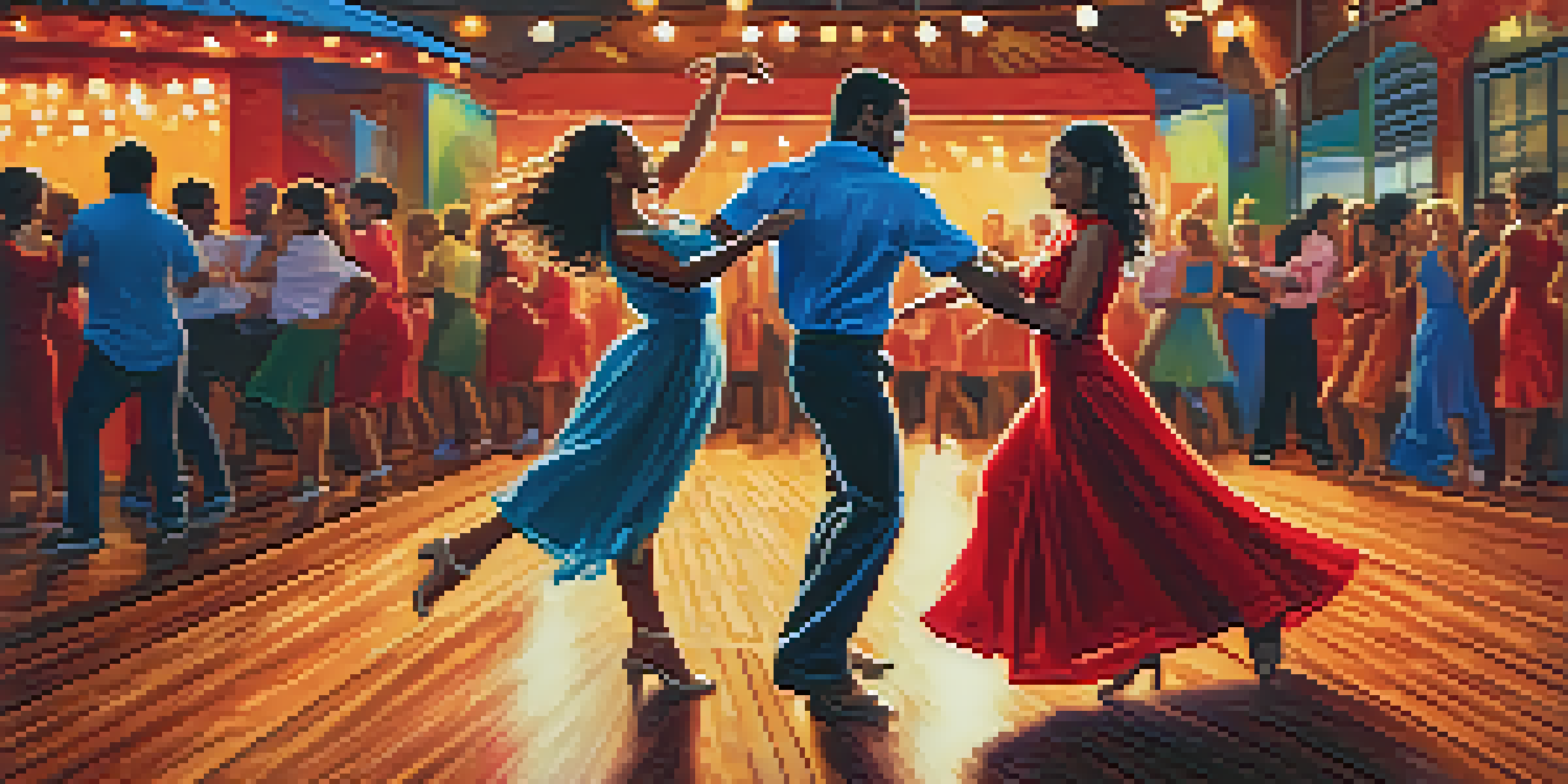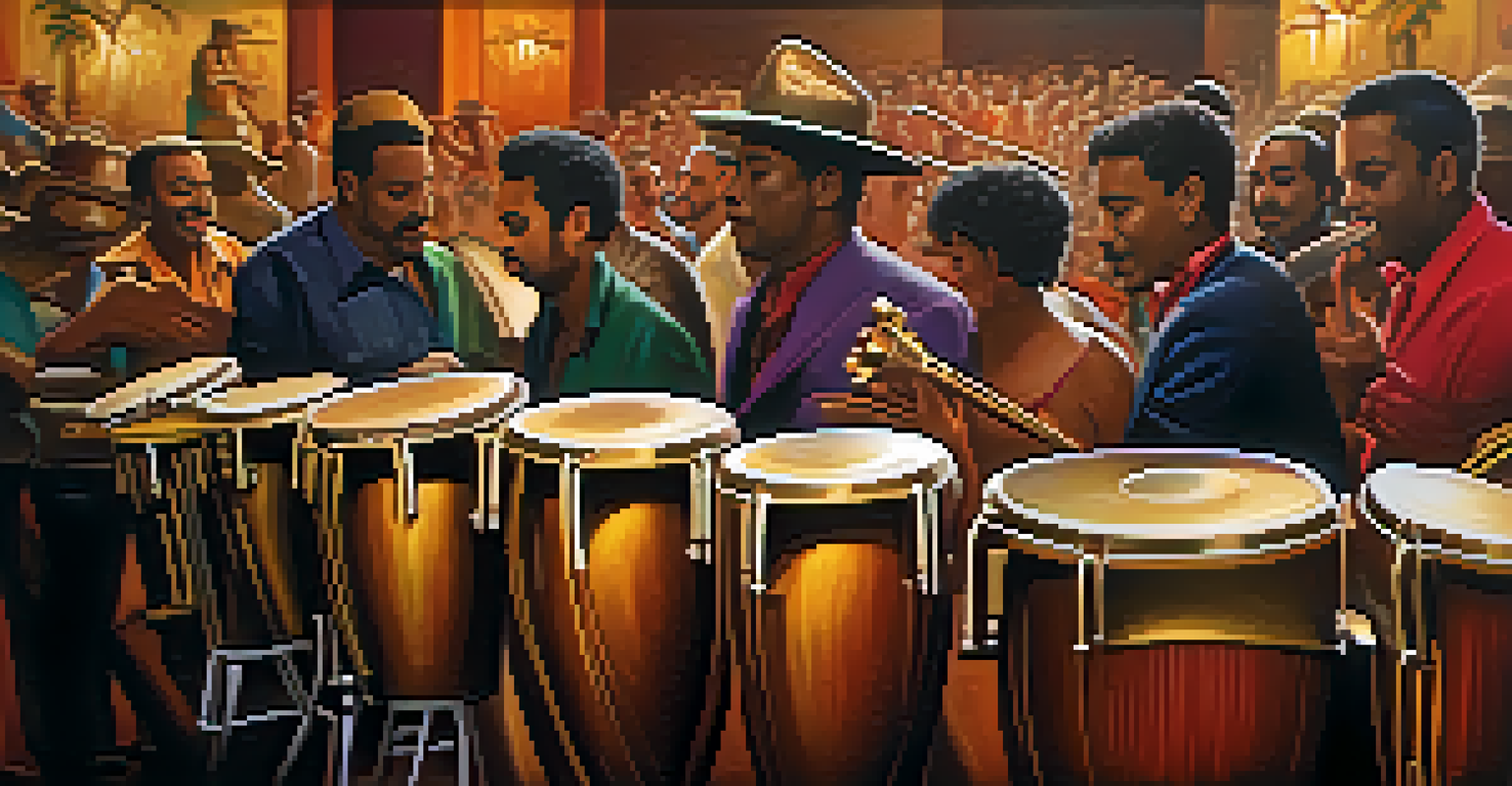Exploring the Roots of Salsa: Dance, Music, and Culture

What is Salsa? A Brief Introduction to Dance and Music
Salsa is more than just a dance; it's a lively blend of rhythms, cultures, and emotions. Originating from a mix of Cuban son, jazz, and Afro-Caribbean influences, salsa has evolved into a global phenomenon that captivates audiences everywhere. The music typically features bright brass, syncopated rhythms, and infectious melodies that compel you to move.
Salsa is not just a dance; it’s a way of life, a way of expressing who you are.
The dance aspect of salsa is just as dynamic, characterized by fast footwork and smooth, flowing movements. Whether you're dancing solo or with a partner, salsa emphasizes connection and expression, making each performance a unique experience. It's this interplay of music and dance that truly defines what salsa is all about.
In essence, salsa embodies a celebration of life, culture, and community. It invites people from all walks of life to come together on the dance floor, fostering a sense of belonging and joy. As we explore its roots, we'll uncover the rich tapestry that forms the foundation of this vibrant art form.
The Origins of Salsa: A Cultural Melting Pot
Salsa's roots can be traced back to the Caribbean, particularly Cuba, where a fusion of African rhythms and Spanish melodies took shape. This unique blend laid the groundwork for what would become the salsa we know today. However, the influence of other cultures, such as Puerto Rican and Dominican, also played a significant role in its development.

In the early 20th century, the music and dance began to spread beyond the Caribbean, particularly as immigrants brought their cultural heritage to cities like New York. Here, salsa continued to evolve, incorporating elements of jazz and other musical styles, creating a vibrant and diverse sound. This cultural exchange is what makes salsa such a rich and multi-layered genre.
Salsa: A Cultural Fusion
Salsa is a lively blend of rhythms and cultures, rooted in Caribbean influences, particularly from Cuba and Puerto Rico.
As we look at salsa's origins, it's clear that it is a product of collaboration and creativity. Each cultural influence adds depth and character, making salsa not just a dance or a genre of music, but a reflection of shared history and experiences among various communities.
The Musical Elements of Salsa: Rhythm and Melody Intertwined
At the heart of salsa music lies its infectious rhythm, often driven by percussion instruments like congas, timbales, and bongos. These instruments create a lively backdrop that invites dancers to express themselves on the floor. The clave, a two-bar rhythm pattern, serves as the backbone of many salsa songs, providing a framework that musicians and dancers can build upon.
Dance is the hidden language of the soul.
The melodies in salsa are equally captivating, typically featuring brass instruments such as trumpets and trombones that add a vibrant flair. Singers often deliver passionate lyrics that tell stories of love, struggle, and celebration, further enhancing the emotional connection to the music. This combination of rhythm and melody creates a sound that's impossible to resist.
Understanding these musical elements is essential for anyone looking to appreciate salsa fully. The intricate interplay between rhythm and melody not only defines the genre but also influences how dancers interpret the music. This dynamic relationship is what makes salsa a thrilling experience, both on and off the dance floor.
Salsa Dance Styles: From Cuban to New York
Salsa is not a one-size-fits-all dance; it features various styles that have emerged over the years, each with its unique flair. Cuban salsa, or 'Son,' emphasizes circular movements and connection with your partner, while Los Angeles-style salsa is known for its flashy footwork and showy turns. New York-style salsa, on the other hand, incorporates influences from jazz and hip-hop, creating a distinct urban vibe.
These different styles reflect the diverse cultural influences that have shaped salsa over time. Each region puts its own spin on the dance, resulting in a rich tapestry of movements and techniques. This diversity is what keeps salsa fresh and exciting, allowing dancers to explore various interpretations and expressions.
Dynamic Dance Styles
Salsa features various styles, including Cuban, Los Angeles, and New York, each reflecting unique cultural influences and expressions.
By understanding these styles, dancers can choose the approach that resonates with them the most. Whether you prefer the romantic, close embrace of Cuban salsa or the bold, dynamic flair of New York salsa, there's a style for everyone, making salsa an inclusive and engaging dance experience.
The Role of Salsa in Cultural Identity and Community
Salsa has always been more than just entertainment; it serves as an essential part of cultural identity for many communities. In cities with large Latino populations, salsa music and dance play a pivotal role in preserving traditions and fostering a sense of belonging. Community events, such as salsa nights and dance festivals, provide spaces for people to celebrate their heritage and connect with others.
Through salsa, individuals can express their stories, emotions, and experiences, making it a powerful tool for cultural expression. It allows people to celebrate their roots while also inviting others to join in the festivities, creating a bridge between cultures. This sense of unity is particularly evident during live performances, where audiences come together to share in the experience.
As we explore the impact of salsa on cultural identity, it's clear that the dance and music form an integral part of community life. They offer a platform for storytelling and connection, reinforcing bonds among individuals while celebrating the rich tapestry of cultural diversity.
Salsa in Popular Culture: From Dance Floors to the Big Screen
Salsa's vibrant energy has made its way into popular culture, influencing movies, television shows, and even fashion. Films like 'Dirty Dancing: Havana Nights' and 'Cuban Fury' have showcased salsa's allure, bringing it to a broader audience. These portrayals not only entertain but also introduce viewers to the rich history and artistry behind the dance.
Television programs featuring salsa competitions, such as 'Dancing with the Stars,' have further popularized the dance, inspiring new generations to take up salsa lessons. These platforms provide visibility to salsa, demonstrating its relevance in contemporary culture while showcasing the talent of skilled dancers and musicians.
Salsa's Cultural Significance
Salsa plays a crucial role in cultural identity and community, allowing individuals to celebrate their heritage and connect with others.
The impact of salsa on popular culture underscores its ability to transcend boundaries and connect people through shared experiences. As more individuals become familiar with salsa, the dance continues to thrive, ensuring that its roots and cultural significance are preserved for future generations.
Learning Salsa: A Journey of Discovery and Connection
For those eager to dive into the world of salsa, the journey begins with finding the right class or instructor. Many studios offer beginner-friendly lessons that cater to all skill levels, making it easy to join the fun. Learning salsa can be a thrilling experience, as you discover the rhythm and movements that define the dance.
Beyond just the steps, salsa classes foster a sense of community among dancers. As you learn to connect with your partner and express yourself through movement, you'll find that the friendships formed on the dance floor can be just as rewarding as mastering the dance itself. This sense of belonging enhances the overall experience and encourages personal growth.

Ultimately, learning salsa is about more than just acquiring a new skill; it's a journey that connects you with a rich cultural heritage. Through dance, you'll not only gain confidence and creativity but also become part of a vibrant community that celebrates life, music, and connection. So why not take that first step onto the dance floor?